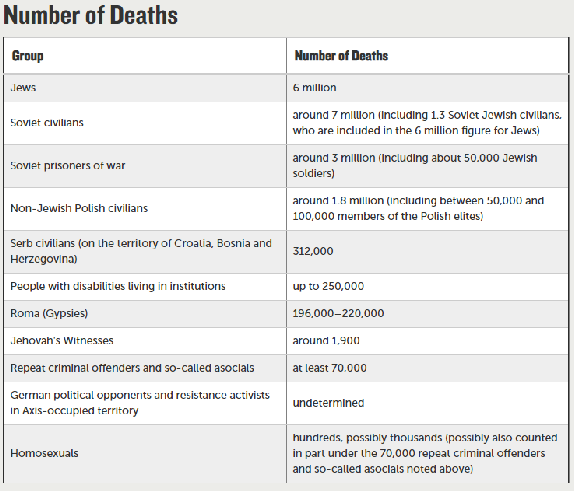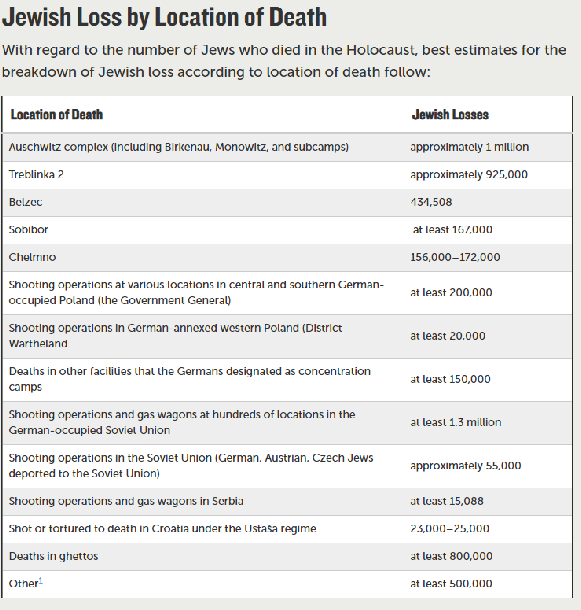|
PART 1 T O P I C |
|
|
|
|
|
|
|
|
|
|
|
|
|
|
|
|
|
|
|
CLICK BUTTON TO GO |
|
|
|
|
|
|
|
|
|
|
|
|
|
Videos |
|
|
|
|
|
|
|
|
|
|
|
|
JewishWikipedia.info
Go to
Timeline for a detailed timeline of the Holocaust
Genocide
Holocaust Memorial Day
The end of WW2 revealed the full horror of Hitler's plans to exterminate
Europe's Jews and other minorities.
What happened in Germany ?
How much was known inside and outside Germany of these mass murders?
VICTIMS OF THE HOLOCAUST AND NAZI PERSECUTION
United States Holocaust Memorial Museum
The Holocaust is the best documented case of genocide. Despite this, calculating the numbers of individuals who were killed as the result of Nazi policies is an impossible task. There is no single wartime document that spells out how many people were killed. And in some cases, contrary to popular opinion, records were not kept.
- Towards the end of the war, the Nazis and their collaborators attempted to destroy much of the existing documentation and other physical evidence.
- To accurately estimate the extent of human losses, scholars, governmental agencies, and Jewish organizations since the 1940s have relied on a variety of different records—including census reports, captured German and Axis archives, and postwar investigations.
- Current estimates might change as new documents are discovered or as historians arrive at a more precise understanding of the events.
Go to website for samples of documents
What follows are the current best estimates of civilians and disarmed soldiers killed by the Nazi regime and its collaborators.
These estimates are calculated from wartime reports generated by those who implemented Nazi population policy, and postwar demographic studies on population loss during World War
Notes on Documentation
NO SINGLE WARTIME DOCUMENT
There is no single wartime document that contains the above cited estimates of Jewish deaths.
There are three obvious and interrelated reasons for the lack of a single document:
- Compilation of comprehensive statistics of Jews killed by German and other Axis authorities began in 1942 and 1943. It broke down during the last year and a half of the war.
- Beginning in 1943, as it became clear that they would lose the war, the Germans and their Axis partners destroyed much of the existing documentation. They also destroyed physical evidence of mass murder.
- No personnel were available or inclined to count Jewish deaths until the very end of World War II and the Nazi regime. Hence, total estimates are calculated only after the end of the war and are based on demographic loss data and the documents of the perpetrators. Though fragmentary, these sources provide essential figures from which to make calculations.
One centrally directed statistical study of Jews killed by German authorities survived the war. A copy was among the records captured by the US Army in 1945. Likewise, several regional compilations of such gruesome data were among the records captured by US, British, and Soviet forces after World War II. The US, Great Britain, and the Soviet Union have used most of these documents at one time or another as exhibits in criminal or civil proceedings against Nazi offenders
POLISH AND SOVIET CIVILIAN FIGURES
With regard to the Polish and Soviet civilian figures, at this time there are not sufficient demographic tools to enable historians to distinguish between:
1. racially targeted individuals
2. persons actually or believed to be active in underground resistance
3. persons killed in reprisal for some actual or perceived resistance activity carried out by someone else
4. losses due to so-called collateral damage in actual military operations
Virtually all deaths of Soviet, Polish, and Serb civilians during the course of military and anti-partisan operations had, however, a racist component. German units conducted those operations with an ideologically driven and willful disregard for civilian life.
Note (1)
"Other" includes, for example, persons killed in shooting operations in Poland in 1939–1940; as partisans in Yugoslavia, Greece, Italy, France or Belgium; in labor battalions in Hungary; during antisemitic actions in Germany and Austria before the war; by the Iron Guard in Romania, 1940–1941; and on evacuation marches from concentration camps and labor camps in the last six months of World War II. It also includes people caught in hiding and killed in Poland, Serbia, and elsewhere in German-occupied Europe.
CRITICAL THINKING QUESTIONS
Why is it challenging to calculate exactly the number of victims of the Holocaust?
Why is it important to document the events of the Holocaust?
Research the roles and complicity of professionals such as record keepers, photographers, and accountants who created documentation of mass murder or witnessed it.
Holocaust victims were people who were targeted by the government of Nazi Germany for various discriminatory practices due to their ethnicity, religion, political beliefs, or sexual orientation. These institutionalized practices came to be called The Holocaust, and they began with legalized social discrimination against specific groups, and involuntary hospitalization, euthanasia, and forced sterilization of those considered physically or mentally unfit for society. These practices escalated during World War II to include non-judicial incarceration, confiscation of property, forced labor, sexual slavery, medical experimentation, and death through overwork, undernourishment, and execution through a variety of methods, with the genocide of different groups as the primary goal.
According to the United States Holocaust Memorial Museum (USHMM), the country's official memorial to the Holocaust, "The Holocaust was the murder of six million Jews and millions of others by the Nazis and their collaborators during World War II."[18] The museum puts the total number of murdered during the Holocaust at 17 million: 6 million Jews and 11 million others
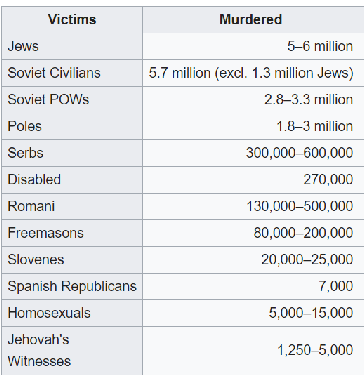
Non-Jewish Holocaust Victims : The 5,000,000 others
5 (this figure excludes the 4.4 million Soviet civilians included in the
Table above) million of those murdered were non-Jewish.
Others were Nazi victims because of what they did, who they were,
their genetic or cultural origins, or health conditions.
BBC 24 September 2014 Last updated: 21/04/06
Approximately 11 million people were killed because of Nazi genocidal policy.
5 million of those murdered were non-Jewish.
Others were Nazi victims because of what they did, who they were, their genetic or cultural origins, or health conditions.
It was the explicit aim of Hitler's regime to create a European world both dominated and populated by the Aryan race. The Nazi machinery was dedicated to eradicating millions of people it deemed undesirable.
Some people were undesirable by Nazi standards because of who they were, their genetic or cultural origins, or health conditions. These included Jews, Gypsies, Poles and other Slavs, and people with physical or mental disabilities.
Others were Nazi victims because of what they did. These victims of the Nazi regime included Jehovah's Witnesses, homosexuals, the dissenting clergy, Communists, Socialists, ‘asocial’s, and other political enemies.
Those believed by Hitler and the Nazis to be enemies of the state were banished to camps. Inside the concentration camps, prisoners were forced to wear various coloured triangles, each colour denoting a different group.
The letters on the triangular badges designated the prisoners' countries of origin.
POLES AND OTHER SLAVS
Christian Poles and other Slavs, notably Ukrainians and Byelorussians, were also primary targets of Nazi Germany hatred during World War II.
To the Nazis, the Slavs were considered Untermenschen,or subhumans, and nothing more than obstacles to gaining territory necessary for the superior German race.
There was not one badge designation for Poles and other Slavs. Rather, a Polish or Slavic person was categorized as a criminal, asocial, political prisoner, and so on.
The Roma, a nomadic people believed to have come originally from northwest India, consisted of several tribes or nations.
ROMA GYPSIES IN CONCENTRATION CAMP
Most of the Roma who had settled in Germany belonged to the Sinti nation.
The Sinti and Roma had been persecuted for centuries. The Nazi regime continued the persecution, viewing the Roma both as asocial and as racially inferior to Germans.
Like Jews, they were deprived of their civil rights. In June 1936, a Central Office to "Combat the Gypsy Nuisance" opened in Munich. By 1938, Sinti and Roma were being deported to concentration camps.
By 1943, a large area of the camp complex Auschwitz-Birkenau was assigned to house deported Sinti and Roma.
The number of inmates is estimated to have been some 23,000. Many became the victim of medical experiments; others died of exhaustion or were suffocated by poison gas.
The camp was dissolved in August 1944. Many of its prisoners were murdered or transferred to other camps. Gypsies wore brown cloth triangles.
HOMOSEXUALS
A state policy of persecution of homosexuals began in Germany in 1933.
Publications by and about homosexuals were prohibited and burned.
In 1934, a special Gestapo division on homosexuals was set up. German police raided gay clubs and bars and made arrests.
Some homosexuals spent time in regular prisons, and an estimated 5,000-15,000 were sent to concentration camps.
Those defined as homosexuals were designated by a triangle of pink cloth attached to their clothing.
JEHOVAH’S WITNESSES
In 1933, the Jehovah's Witnesses in Germany totaled about twenty thousand.
In 1934, Jehovah's Witnesses attempted to fend off Nazi attacks by having congregations send letters to the government explaining their beliefs and political neutrality.
The group was banned by national law in April 1935. Those Witnesses who defied the ban on their activities were arrested and sent to prisons and concentration camps.
Jehovah’s witnesses were marked with purple triangular badges. Approximately 2,500 to 5,000 died in Dachau, Belsen, Buchenwald, Auschwitz, and other camps.
PHYSICAL & MENTALLY DISABLED
These people never were assigned a badge because they were rarely sent to concentration camps.
Persons with physical or mental disabilities threatened the Nazi plan for human "perfection."
In 1934, forced sterilization programs sterilized 300,000 - 400,000 people, mainly those in mental hospitals and other institutions.
POLITICAL AND RELIGIOUS DISSIDENTS
The remnants of the Communist and Socialist parties and members of the trade unions resisted the Nazi regime.
As did any members of the clergy, of all denominations, who like Pastor Martin Niemöller , opposed Adolf Hitler's efforts to bring the German churches under control of the Nazis.
He also founded the Pastors' Emergency League, a group, among its other activities, helped combat rising discrimination against Christians of Jewish background.
In 1937, Niemoller was imprisoned for four years in solitary confinement and eventually sent to Sachsenhausen and then to Dachau concentration camps, he was moved in 1945 to the Tirol, where Allied forces freed him at the end of World War II.
In the early years of the Third Reich, political prisoners were a significant portion of the concentration camp inmates. At the end of July 1933, about 27,000 political prisoners were being held in concentration camps in "protective custody."
Dachau was always a camp for political prisoners.
Nazi propaganda poster discouraging racial mixing
Nazi's promoted racist propaganda
AFRICAN-GERMANS
When the Nazis came to power there were hundreds of African-German children living in the Rhineland, the offspring of German mothers and African soldiers brought in during the French occupation.
Hitler claimed these children were part of a Jewish plot to begin "bastardising the European continent at its core." Under the Nazi regime, African-German children were labeled "Rhineland Bastards" and forcibly sterilized.
JEWS KILLED DURING THE HOLOCAUST BY COUNTRY
Thought Co Jennifer Rosenberg Updated July 13, 2019
During the Holocaust, the Nazis murdered an estimated six million Jews. These were Jews from across Europe who spoke different languages and had different cultures. Some of them were wealthy and some of them were poor. Some were assimilated and some were Orthodox. What they did have in common was that all of them had at least one Jewish grandparent, which was how the Nazis defined who was Jewish.
The Nazis forced Jews out of their homes, crowded them into ghettos, and then deported them to either a concentration or a death camp.
Most died of starvation, disease, overwork, shooting, or gas. After death, their bodies were either dumped into a mass grave or cremated.
Never in the history of the world had there been such a large-scale, systematic genocide as that conducted by the Nazis during the Holocaust.
ESTIMATING THE HOLOCAUST MURDERS
Because of the vast numbers of Jews murdered, no one is absolutely sure how many died in each camp, but there are good estimates of deaths by the camp. The same is true about estimates per country.
There is no single wartime document that estimates the number of Jewish deaths during the Holocaust. Between 1942 and 1943, the Nazis did attempt to compile statistics for their final solution. One copy of that record was captured by the U.S. Army in 1945. By late 1943, however, the German and Axis authorities recognized they were losing the war and had no time to continue counting. Instead, they ramped up the number of deaths and began destroying existing records and evidence of previous mass murders.
Total estimates used today are based on postwar studies and research of the existing data.
NEW ESTIMATES
A study published in 2013 by the United States Holocaust Memorial Museum, based on a painstaking evaluation of available documents and investigation of 42,000 camps and ghettos, identified that the total number of deaths was almost double the numbers generated shortly after the war.
In addition to at least 7 million Jews killed, the Axis killed around 5.7 million non-Jewish Soviet citizens, around 3 million non-Jewish Soviet prisoners of war, 300,000 Serb citizens, around 250,000 people with disabilities living in institutions, and around 300,000 Roma (Gypsies). Jehovah's Witnesses, homosexuals, and German political opponents account for at least another 100,000 people. Estimates of the total number of people who died in the Holocaust now range between 15 and 20 million.
Jews Killed in the Holocaust by Country
The following chart shows the estimated number of Jews killed during the Holocaust by country. Notice that Poland by far lost the largest number (three million), with Russia having lost the second most (one million). The third highest losses were from Hungary (550,000).
Notice also that despite the smaller numbers in Slovakia and Greece, for example, they still lost an estimated 80 and 87 percent, respectively, of their pre-war Jewish populations.
The totals for all countries show that an estimated 58 percent of all Jews in Europe were killed during the Holocaust.
The following figures are estimates based on census reports, captured German and Axis archived records, and postwar investigations.
These are the numbers according to the latest investigations
by The U.S. Museum of the Holocaust.
ESTIMATED MURDERED
COUNTRY
PRE-WAR JEWISH POPULATION ESTIMATED MURDERED
ALBANIA 200 UNKNOWN
AUSTRIA 185,000 65,500
BELGIUM 90,000 25,000
BULGARIA 50,000 UNKNOWN
CZECHOSLOVAKIA 709,000 590,000
DENMARK 7,500 80
ESTONIA 4,500 1,000
FRANCE 315,000 74,000
GERMANY 237,000 165,000
GREECE 72,000 69,000
HUNGARY 825,000 560,000
ITALY 100,000 8,000
LATVIA 93,500 70,000
LITHUANIA 153,000 130,000
LUXEMBOURG 4,000 1,200
NETHERLANDS 140,000 100,000
NORWAY 1,800 760
POLAND 3,350,000 3,000,000
ROMANIA 1,070,000 480,000
SOVIET UNION 3,030,000 1,340,000
YUGOSLAVIA 203,500 164,500
TOTAL: 10,641,800 6,844,040
SEE ALSO
DOCUMENTING NUMBERS OF VICTIMS OF THE HOLOCAUST AND NAZI PERSECUTIONDOCUMENTING NUMBERS OF VICTIMS OF THE HOLOCAUST AND NAZI PERSECUTION
(Holocaust Museum)
WHY DID ORDINARY PEOPLE COMMIT ATROCITIES
IN THE HOLOCAUST?
BBC
Presented by Natasha Kaplinsky In association with HETExternal
GO TO WEBSITE TO SEE VIDEOS
 See also CARING CORRUPTED -
See also CARING CORRUPTED -
THE KILLING NURSES OF THE THIRD REICH
1. ORDINARY PEOPLE
Around six million people were killed in the Holocaust, the Nazis' systematic attempt to exterminate the Jewish people. Jews from across Germany and Nazi-occupied Europe were rounded up, and either transported to extermination camps where they were gassed, shot locally, or starved and abused in ghettos and labour camps until they died.
This was murder on an industrial scale, and it took an industrial process to do it. From the office workers who planned and oversaw the logistics, to the railway staff who ran the trains, to the community policemen who guarded the streets, hundreds of thousands of ordinary people were part of this attempted genocide.
It can be hard for us to even try to understand how this was possible. We might assume that ordinary citizens were so terrified of retribution from the vicious Nazi regime that they reluctantly went along with it. But the truth is far more disturbing than that. In fact, thousands of people, who had lived side by side with their Jewish neighbours for generations, were quite willing to turn on them and become part of a programme of mass murder.
2. WHO WERE THEY?
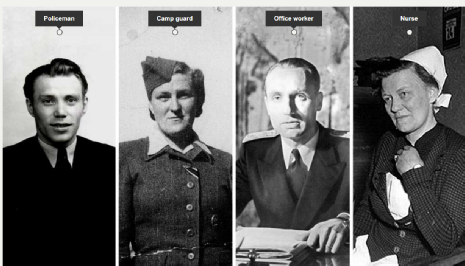
Policeman
Anthony Sawoniuk
As a boy, Anthony Sawoniuk earned money running errands for Jews on the Sabbath.
In 1941, his home town of Domaczewo (then part of Poland, now in Belarus) was captured by the Nazis. He volunteered to join the auxiliary police. His unit guarded the local Jewish ghetto.
On 20 September 1942, nearly 3,000 Jews were rounded up and murdered. Sawoniuk led search-and-kill police squads that hunted down those who tried to escape.
Police squads like this were set up across Poland, Ukraine, Latvia and Lithuania. They were trained to fight against partisans and also murder Jews.
Camp Guard
Hermine Braunsteiner
Austrian-born Hermine Braunsteiner could not afford to fulfil her ambition to become a nurse, so worked as a maid instead. After the Nazis annexed Austria she started working in an aircraft factory in Berlin, and then took a better-paid job as a guard at Ravensbrück, a women's concentration camp.
She was later transferred to Majdanek in Poland, a concentration camp which also served as an extermination site. She was involved in selecting women and children to be sent to the camp's gas chambers and became infamous for her brutality towards prisoners.
By the end of the war there were 3,500 female guards employed in various concentration camps.
Office Worker
Maurice Papon
After attending one of France's most prestigious schools, Maurice Papon joined the civil service and rose rapidly through its ranks.
When the Nazis occupied France in 1940, he kept his job and served in the collaborationist Vichy government. He was responsible for Jewish policy in the Bordeaux region, and signed documents which led to the deportation of almost 1,600 Jews to a transit camp outside Paris. Most of them were later deported to Auschwitz, where they were murdered.
Across Nazi occupied Europe there were thousands of "desk murderers" who assisted the logistics and administration of mass slaughter from remote offices.
Nurse
Imgard Huber
At the beginning of the war, Irmgard Huber was head nurse at the psychiatric hospital in her hometown in Germany.
In 1940 the hospital became a T4 killing centre. T4 was the codename given to the Nazi operation in which around 70,000 German and Austrian adults with mental or physical disabilities were murdered. At least 14,000 people were killed at her hospital. Huber was responsible for the drugs which were used in the lethal injections. She also had a role in falsifying death certificates which were sent to families of the victims.
Doctors, nurses and administrators worked in six killing centres across Germany and Austria. They were the testing ground for the death camps in Eastern Europe.
Although some ordinary people in Germany and occupied Europe were brave enough to help the Jews, others became killers. Looking at the background of just four of the people involved in the Holocaust and wider Nazi atrocities against the disabled and other groups, shows that there was nothing that marked them out as sadistic murderers.
3. WHY DID THEY DO IT?
What motivated people to become killers in the Holocaust? Natasha Kaplinsky looks at the evidence. Click on the website labels to find out more.
4. 'JUST FOLLOWING ORDERS'
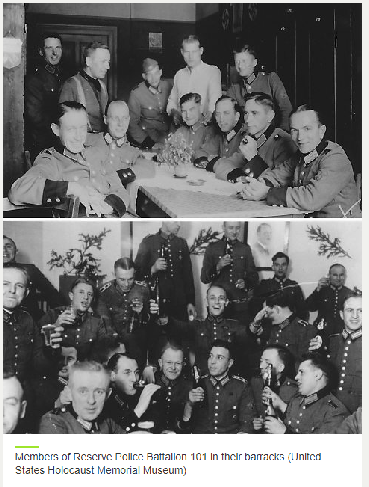 After the war, many of the people who played their part in the Holocaust said that they had no choice but to follow orders. Yet historians and German prosecutors have failed to find a single case of any person being threatened with death or imprisonment for refusing to take part.
After the war, many of the people who played their part in the Holocaust said that they had no choice but to follow orders. Yet historians and German prosecutors have failed to find a single case of any person being threatened with death or imprisonment for refusing to take part.
The story of Reserve Police Battalion 101 shows that even when given a choice to opt out, ordinary people went on to commit atrocities.
In 1942 the battalion was sent to Poland to take part in the rounding up of Jews. It was made up of ordinary middle-aged men, many with families.
Major Trapp's story
Just three weeks after their arrival, the men were sent to the village of Józefów, home to 1,800 Jews. The commander, Major Wilhelm Trapp, stood up in front of the gathered men. As he began to speak they noticed he had tears in his eyes.
Trapp told his men to round up all the Jews living in this village as there had been reports that they were involved with the local partisans.
He said that they should separate the Jewish men so they could be sent off to a work camp. However, the woman, children and the elderly should be taken aside and shot - and although he did not like what they had been asked to do, it would make it easier if they remembered that, back home in Germany, bombs were falling on women and children.
At the end of his speech, Trapp said that those who did not want to take part, could step aside. Of the 500 men standing there that day only fifteen chose to opt out of the killing. The rest went on to massacre all the Jewish women, children and elderly people in the village.
Over the course of the war the battalion went on to murder thousands of Jews.
5. CALLED TO ACCOUNT
Although some high-ranking Nazis were prosecuted at the Nuremberg and later trials, many perpetrators were never investigated. The sheer number of people involved made it logistically impossible. Once the Cold War started, the Allies spent less and less time pursuing perpetrators. West German and Austrian authorities were also unwilling to investigate large numbers of their citizens. Some had fled to South America, where right-wing dictatorships offered them refuge. Others found their way to the US, Canada and Britain. Presenting themselves as refugees from communist regimes, they were rarely questioned about their wartime activities.
Click on the website labels to find out more.
6. COULD IT HAPPEN AGAIN?
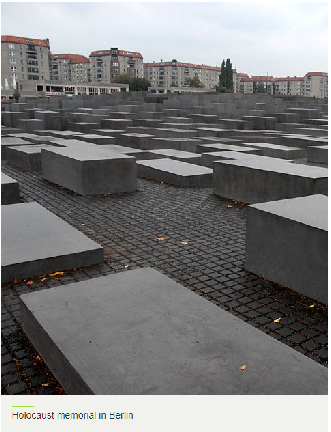
In many ways the Holocaust was the most modern genocide the world has ever seen - carried out using all the bureaucratic institutional capacity of the modern state; aimed at eliminating Jews wherever they were caught, anywhere in the world. Might we ever experience anything on this scale again?
Christopher Browning, Holocaust historian
Sadly, one thing that we've learnt is that we seldom learn from history. There are many singular aspects about the Holocaust, but the nature of killers does not seem to be one of them. Any government that has wanted to commit genocide has not failed from a shortage of executioners.
Governments have the power to create an institutional, organisational, situational framework that will harness people to kill. They prey on people's conformity, their deference, and their desire to be held in the esteem of their comrades.
If there are historical circumstances where a traditional dehumanising stereotype already exists, then it’s so much easier to implant fear and dress up what’s being done in terms of self defence against some alleged ominous enemy.
However, we do know from past situations that it doesn’t require centuries of hatred or long term animosity. In fact, mobilization for mass killing has been accomplished very quickly.
Jennifer Welsh, UN Special Adviser
The international community has learnt not only from the Holocaust, but also from the genocide in Rwanda 20 years ago. Since World War Two, the international community has criminalized genocide and established the International Criminal Court, more recently with the creation of the Criminal Tribunals for the former Yugoslavia and for Rwanda.
They work to create a culture of accountability and to combat a culture of impunity. Those who contemplate inciting or organising these atrocity crimes know that they could be held to account for their actions. They have created a climate in which acts of this kind are no longer seen as something within the domestic jurisdiction of states, or as part of the 'normal' course of war. They are now a matter of international concern, and can be discussed in international forums such as the United Nations Security Council.
Even so, we cannot say enough has been done, as we continue to see some instances of crimes against humanity or genocide which have not galvanized sufficient international action. Given constraints on the capacity of outside actors to respond, or strong political interests working against international action from powerful neighbours, we still do not see consistently strong responses to evidence of atrocity crimes.
Philippe Sands QC, Professor of international law
The current system of international law places important constraints on the power of the state, but it has not stopped atrocity. If there is inadequacy, it is not in the content of the rules but in their enforcement. It is inadequate in many countries, and it is inadequate at the international level. The International Criminal Court has begun to operate in relation to some crimes, but only in Africa, a continent that does not have a monopoly in respect of international crimes.
Mass killings and atrocities did not end in 1945. Around the world there have been terrible events, as we all know, and no continent has been immune from large-scale killings in which great numbers of individuals have been targeted and killed because they happen to be a member of a particular group – racial, religious, ethnic, political and so on. Each situation is different, to be understood in its own context. Could acts akin to the Holocaust happen again today? Yes.
THE ROOTS OF EXTREMISM
BBC Click here to go to Soundtrack
What drives people to exterminate others? The historian Daniel Pick reveals the story of an extraordinary project which aimed to unearth persecution's roots, from witch-hunts to the Holocaust and beyond.
In 1961, Adolf Eichmann, one of the chief organisers of the Holocaust, was tried in Jerusalem. Among those deeply troubled by his apparent ordinariness was David Astor, the editor of the Observer .
Astor was also an enthusiastic champion of psychoanalysis, and made a speech declaring that the 'political psychopathology' of Nazism - and other examples of persecution and extermination - should be investigated. And he had the money to make this happen.
The historian Norman Cohn contacted Astor and offered to help. Cohn was the author of The Pursuit of the Millennium, a pioneering study of the ways medieval utopian visions led to 'purifying' massacres.
With Astor's support, Cohn set up the Columbus Centre, a team of historians, sociologists and other scholars who set about investigating the psychological roots of the Nazi mass killings of Jews and Gypsies, and much earlier examples such as the witch-hunts across Europe in the Middle Ages.
One member of the team, psychiatrist Dr Henry Dicks, even visited West German prisons to interview convicted SS killers and concentration camp guards face to face.
In this programme, Daniel Pick investigates the story of the Columbus Centre, drawing on exclusive access to private recordings of the Centre's meetings.
And he explores the impact of the project today, from terrorism studies to the Tribunal that tried the perpetrators of the Rwanda genocide.
With: Jeremy Lewis, Lucy Astor, Adrian Dicks, Marina Voikhanskaya, Steven Reicher, John Horgan, Frank Chalk, Albie Sachs.
Producer: Phil Tinline.
THE START OF THE MASS MURDER
Holocaust.cz
On the 22nd of June 1941, German troops launched Operation Barbarossa, Germany's attack on the Soviet Union. From the point of view of the Nazis, this was not an ordinary military conflict, but a battle against the chief ideological and racial enemy of the German nation. Since the 1920s, the Nazis had declared Bolshevism to be the greatest threat to European society, and claimed that the Soviet regime was a front for a Jewish conspiracy that aimed to rule the other nations. As the Nazis penetrated into the interior of the Soviet Union, they gained control over the numerous Jewish communities that were dotted in a broad band spreading from the Baltics, across Belarus and Ukraine to the Black Sea.
At the rear of the German army were four Einsatzgruppen (link in Czech) - special units whose task was the fight against ideological opponents. They were required to kill all Communist functionaries, Jews holding party and state functions, and other „radical elements“. In reality, however, the main role of these units was to massacre the Jewish communities. To begin with, only Jewish men were murdered, but soon women and children were also being killed. The largest single massacre was the execution of over 30 000 Kievan Jews in Babi Yar at the end of September 1941. It is estimated that these units, aided by local militia and in coordination with the army, slaughtered approximately 1.25 million Jews in all, as well as hundreds of thousands of other Soviet citizens.
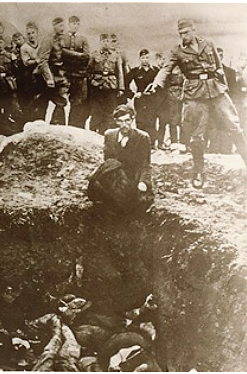
Einsatzgruppen executing Jews in Ukraine, 1942. (Photo: Library of Congress, courtesy of USHMM Photo Archives.)
From the invasion of the Soviet Union onwards, however, the genocidal policy implemented in the occupied Soviet territories was to be extended to all Jews in the Nazi sphere of power. The decision to kill the European Jews was undoubtedly taken by spring 1941 at the latest. Himmler's SS faced a double problem, however firstly, finding a suitable and effective method of killing, and secondly, transporting the victims to the place of their death.
The Nazis experimented in their search for the most effective killing method, one which would not take such a heavy toll on the killers' psyche as the mass shootings that were carried out by the Einsatzgruppen in the conquered territories. Indeed, it was the Einsatzgruppen who in November 1941 started to use a new method of extermination - mobile gas chambers, in which the victims were killed by exhaust gas. From December 1941 on, these lethal vehicles were used in Chelmno. A total of 20 mobile gas chambers were produced.
In 1942 the already-existing concentration and labour camps in the Generalgouvernment were transformed into extermination camps, the task of which was to murder the greatest number of victims in as „effective“ a way as possible. Killing by gas, which had already been used in the „euthanasia programme“ (link in Czech), was now considered by the Nazi planners to be the most suitable way of carrying out the murder of millions of people. From the start of 1942 on, extermination centres were gradually created, equipped with permanent gas chambers. Some of the staff who had gained experience in the „euthanasia“ programme was now transferred to the camps designated for the mass murder of Jews, where they set up the gas chambers. In February they were installed in Bełżec, in May in Sobibor, in July in Treblinka and in Majdanek they were in operation from September 1942. These gas chambers were usually disguised as showers, and used exhaust fumes to kill. The whole operation was named Operation Reinhard, after Reinhard Heydrich, who had been assassinated by Czechoslovak parachutists in Prague on the 27th of May 1942. It did not end until the close of 1943, when the extermination camps at Bełżec, Sobibor and Treblinka were closed. In all, over 1.7 million Jews were murdered in them while they were in operation.
The chief pillar of the extermination process was the camp at Auschwitz, where between March and June 1943, four new gas chambers were built. These used the poisonous gas Zyklon B to kill. The new gas chambers were installed in the Auschwitz-Birkenau camp, founded near the original camp. Auschwitz received transports from the whole of Nazi-occupied Europe. After arriving in the camp, most of the transports went through „selection“, in which the SS selected a few prisoners for forced labour, the others being sent to immediate death in the gas chambers. Those who were not murdered immediately on arrival were not to be spared, but were to be exterminated in a process known as „Vernichtung durch Arbeit“ - destruction through labour. These prisoners, dispersed throughout the auxiliary Auschwitz and other camps that formed the extensive system of Nazi concentration camps, were forced to engage in slave labour in inhuman conditions, leading to utter exhaustion that usually ended in death.
>> „The territorial solution to the Jewish question“ >>
>> Mass deportations to the concentration and extermination camps >
WHAT DID THE WORLD KNOW?
Holocaust and Human Behavior, Chapter 9
What did the rest of the world know about the Nazis’ policies of annihilation during World War II and the terror and mass murder spreading across Europe as a result?
By summer 1941, British intelligence agents were listening in on classified German radio transmissions that described systematic mass murders in Lithuania, Latvia, and later Ukraine. News also came from the Soviets. On August 14, 1941, British Prime Minister Winston Churchill summarized the news in a broadcast to the public:
As [Hitler’s] armies advance, whole districts are being exterminated. Scores of thousands, literally scores of thousands of executions in cold blood, are being perpetrated by the German police troops upon the Russian patriots who defend their native soil. . . . And this is but the beginning. Famine and pestilence have yet to follow in the bloody ruts of Hitler's tanks.
We are in the presence of a crime without a name.
Additional confirmation came in spring 1942, when American journalists stranded in Germany when the United States entered the war were exchanged for Axis nationals stranded in the United States. Historian Deborah Lipstadt describes the articles these journalists wrote after they returned home:
Glen Stadler, UP [United Press] correspondent in Germany, described what had happened to Jews in Latvia, Estonia, and Lithuania as an “open hunt.” Some of the reporters estimated that more than 400,000 had already been killed by Hitler’s “new order,” including “upward of 100,000 [Jews who] met death in the Baltic states alone, and more than that . . . have been executed in Western Russia.”
Joseph Grigg, also of the UP, reported: “One of the biggest slaughters occurred in Latvia in the summer of 1941 when, responsible Nazi sources admitted, 56,000 men, women and children were killed by S.S. troops and Latvian irregulars.”
News also filtered out of occupied Europe through government channels. Following Poland’s defeat by Germany, Polish leaders had established a temporary “government in exile” in Britain. In June 1942, they received a secret report from occupied Poland confirming that the Germans were murdering Jews throughout the country. Newspapers around the world carried the story.
The London Times reported:
MASSACRE OF JEWS—OVER 1,000,000 DEAD SINCE THE WAR BEGAN
The Montreal Daily Star stated:
“NAZI SLAUGHTERHOUSE”—GERMANS MASSACRE MILLION JEWS IN EXTERMINATION DRIVE
The Los Angeles Times wrote:
NAZIS KILL MILLION JEWS, SAYS SURVEY
The New York Journal American declared:
JEWS LIST THEIR DEAD AT A MILLION
Recalling atrocity stories during World War I that later proved to be false, American journalists tended to be cautious about claims of mass murder. So even though they reported the news, their editors rarely featured those stories on the front page and were careful not to emphasize claims of atrocities. Nevertheless, on December 13, 1942, Edward R. Murrow of the CBS radio network bluntly reported, “What is happening is this. Millions of human beings, most of them Jews, are being gathered up with ruthless efficiency and murdered. The phrase ‘concentration camps’ is obsolete, as out of date as economic sanctions or non-recognition. It is now possible only to speak of extermination camps.”
Four days later, the governments of the United States, Britain, and the Soviet Union issued a joint declaration that “the German authorities, not content with denying to persons of the Jewish race in all the territories over which their barbarous rule has been extended the most elementary human rights, are now carrying into effect Hitler’s oft-repeated intention to exterminate the Jewish people of Europe.” The declaration stated, in part:
Jews are being transported in conditions of appalling horror and brutality to Eastern Europe. In Poland, which has been made the principal Nazi slaughterhouse, the ghettos established by the German invaders are being systematically emptied of all Jews except a few highly skilled workers required for war industries. None of those taken away are ever heard of again. The able-bodied are slowly worked to death in labor camps. The infirm are left to die of exposure and starvation or are deliberately massacred in mass executions. The number of victims of these bloody cruelties is reckoned in many hundreds of thousands of entirely innocent men, women, and children.
The Allies believed that the best way to help the Jews was to win the war. They warned Nazi leaders that they would be held responsible for their crimes once Germany was defeated.
CONNECTION QUESTIONS
- What information was available in Britain and the United States about massacres in the Baltic states and the USSR in the early 1940s? What information was available about the concentration camps and death camps in 1942?
- Why did Churchill call the mass murders of 1941 “a crime without a name”? Why might it make a difference to have a name for a crime?
- Why would articles about mass murder have failed to make the front pages of newspapers around the world? What forces might shape or determine the selection of the stories that newspapers feature today?
A BIOLOGIST RECONSTRUCTS
THE GROTESQUE EFFICIENCY
OF THE NAZIS’ KILLING MACHINE
Lewi Stone used his statistical prowess to reveal the furious intensity of the Holocaust’s industrial-scale genocide during three months of 1942
Scientific American, Gary Stix, January 10 2019
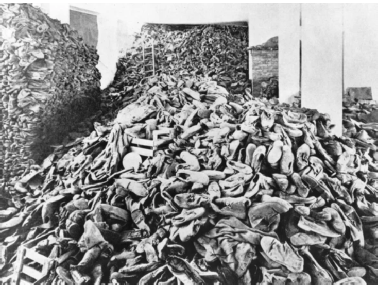
Piled up shoes of murdered prisoners (location not verified, presumably Treblinka). Credit: Getty Images
One of mathematical biologist Lewi Stone’s typical papers bears the title: “The Feasibility and Stability of Large Complex Biological Networks: A Random Matrix Approach.” But the academic, who holds appointments at Tel Aviv University and RMIT University in Melbourne recently went in for a change of pace: This month Science Advances published his study titled “Quantifying the Holocaust: Hyperintense Kill Rates During the Nazi Genocide.”
Stone’s analysis of deportation train records indicates about a quarter of Holocaust deaths was concentrated in a single period, from August through October 1942, at three camps in Poland. And the largest Holocaust murder campaign only abated because so few Jews were left in German-occupied Poland. Stone’s estimates of “kill rates” provide insight into the industrial methods the Nazis brought to bear. Scientific American spoke with Stone about his new paper.
[An edited transcript of the interview follows.]
You’re a mathematical biologist. Why did you decide to study the operations of a Nazi death camp?
When I was a high school student in the ‘70s, before the internet, I found myself hanging around the local library in the Melbourne suburbs. This particular library had a set of shelves in the corner of the building, one of which was dedicated to books on the Holocaust, right by the maths books I was glued to.
Because of my interest in science and maths, one of these books fascinated me. In an appendix at the end of the book there were many carefully prepared charts and statistical tables with estimates of victims killed. The author had obviously gone to a huge amount of trouble to publish this data, but I never understood the purpose of these tables and figures. How did it give insights into the Holocaust? I promised myself that one day I would return to this book, and these data sets, and try to seek out patterns or something useful.
I went on to pursue a career in mathematical biology. Every five to 10 years I tried to search for that original Holocaust book, but never succeeded in finding it again. Meanwhile, for decades I had been working on the modeling of infectious diseases as they spread through contemporary populations during events like the deadly Spanish flu pandemic of 1918.
When a rare data set describing disease outbreaks in the Holocaust reached my hands, I became interested again in World War II. Soon I discovered the remarkable data of the Israeli historian Yitzhak Arad on railway transportation to the death camps—and, by proxy, deaths during Operation Reinhard, the largest single murder campaign within the Holocaust. I understood immediately that much could be learned about the Holocaust from this data set.
Briefly, what did you find?
My work investigates a period in 1942, referred to as Operation Reinhard, when the Nazis efficiently shuttled about 1.7 million victims—often whole Jewish communities—across the European railway network in train carriages to Treblinka, Belzec and Sobibor. Almost all of those who arrived at these death camps were murdered, usually within hours in the gas chambers. Because the Nazis destroyed nearly all records of the massacre, it is important to try to uncover what actually happened at the time.
My study looks at the “kill rate,” or murders per day. My graph of the kill rate reveals a sudden massive slaughter after Hitler “ordered all action speeded up,” as one SS officer put it, on July 23, 1942. Approximately 1.5 million Jews were murdered in only 100 days, including shootings outside the death camps. On average, 450,000 victims were killed each month during August, September and October of that year. That’s approximately 15,000 murders every day.
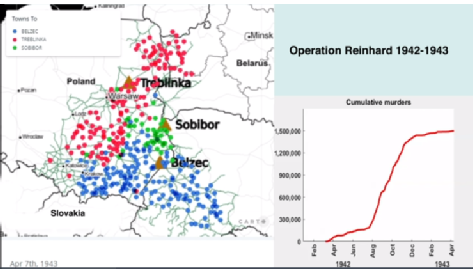 Tally of victims deported to three death camps each month beginning Jan. 1, 1942. Credit: Lewi Stone in Science Advances
Tally of victims deported to three death camps each month beginning Jan. 1, 1942. Credit: Lewi Stone in Science Advances
The slaughter then soon terminated, as there were hardly any Jews remaining in the area to kill. The full scope of this genocidal slaughter and hyperintense killing appears to be documented in history in the vaguest of terms. Available information before this study was mostly reconstructed indirectly, partially conjectured and usually given on an annual timescale rather than daily or monthly. That meant missing the intensity of this three-month slaughter. But Arad’s data allowed me to characterize it far better than other attempts, because the data was given on a daily timescale.
While Operation Reinhard is considered the largest single murder campaign of the Holocaust, the extraordinary speed at which it operated to obliterate the Jewish people has been poorly estimated in the past and almost completely unknown to the general public. The minimal time in which the operation took place indicates the enormous coordination involved by a state machinery responsive to the Fuhrer’s murderous will to eradicate a people. The train records show how zones were emptied of Jewish communities one by one in an organized manner, and how intense kill rates were achieved in targeted areas that only slowed as victims ran out. My plots of the data and a film visualization highlight the pace and frenzy of this mass murder.
The atrocities of the camps are a well-established fact. What did you find in your study that surprised you?
It was the sheer scale of the atrocities that surprised me. The graphs show with chilling immediacy the huge sudden increase in killings in 1942 in Arad’s data set. At the Treblinka death camp, for example, it was not uncommon that two train transportations arrived in a day, bringing in 10,000 victims who were murdered in the gas chambers within hours of arrival. This high volume of killing could at times happen day in, day out.
As Raul Hilberg, author of The Destruction of the European Jews, remarked, “Never before in history had people been killed on an assembly-line basis.” Visualizing the dynamics in the form of graphs somehow re-creates the large-scale picture far more realistically than the proverbial 1,000 words. My spatiotemporal visualization shows a sudden drop in killings—pretty much when the huge area of German-occupied Poland had very few Jewish communities remaining and there were few victims left to murder. This type of data-visualization communicates in a powerful way this pure targeted genocide.
As a scientist, another particularly surprising aspect of this event was to find that the Bletchley Park code-breaking group in England—and perhaps Alan Turing himself, the British scientist who cracked the Germans’ infamous Enigma machine code used by the military to send encrypted messages—played a role in making available statistical data from Operation Reinhard in an indirect but very important manner. In 2000 a cryptic document referred to as the Höfle telegram was discovered in World War II archives in the U.K. British analysts decoded Höfle’s message, encrypted by the Enigma machine on the 11th of January 1943, but most probably they missed its significance. Thanks to the work of historians Peter Witte and Stephen Tyas in 2000, we now understand the telegram contained in a few brief telegraphic lines the detailed statistics on the total 1942 killings in Operation Reinhard death camps at Treblinka, Sobibor, Belzec and a few others. This is a very unusual story, and more research is needed to verify the accuracy of these statistics.
Undertaking this project must have been an emotional experience for you. Can you describe what you felt when you started to get your results?
Emotions definitely came into play even from the outset. I was reluctant for at least six months to go ahead and digitize Arad’s data to a format that I could analyze on the computer. The data after all represents human lives murdered in an extremely tragic genocidal event, making the data in many ways sacred. But since Arad had already compiled the numbers in great detail in his book, I ultimately decided that it would be a shame not to advance his efforts to the next step.
The data covered the 21-month period of Operation Reinhard, and initially I was not sure what to expect. To see that the great bulk of the massacre occurred in just over three months with something like 450,000 murders per month—about 15,000 per day for 100 days—was a life-changing experience for me. I was very shaken up from the graphs. Upon rereading the standard literature one would not come away with the picture I was seeing in the data. More specialist literature gave vague statements that were often not presented in a rigorously justified format, and none gave the “big picture” with the intense three-month period of slaughter I was seeing.
Why is it important to quantify the Holocaust—or other genocidal events—with statistics such as kill rates, tempo and spatial dynamics, going beyond the numbers for how many actually died?
Lack of data and inability to quantify it leads to uncertainty and misinterpretations. You can see it just in the way that Auschwitz was always the central symbol of the Holocaust. Only in recent years is this being reversed as more details of Operation Reinhard come to light. This is partly because there were very few survivors of the Reinhard death camps to leave us with details. All who entered were murdered. The operation was a tight secret and the Nazis destroyed many records. In contrast, there were relatively more survivors from Auschwitz to help reconstruct better the events that occurred there.
The data encodes what actually happened. If you can decode the data, there may be many things to learn that you might not ever be aware of otherwise. This is the great thing about Arad’s data set. It allows us examine what happened with the train transportations to the death camps on a daily timescale. This is a huge advance as it means we now have the dimension of time to work with. Not having a daily time scale, and usually working at annual or semiannual timescales, seriously prevented historians from reporting the three-month peak in the Holocaust kill rate. It was simply off the radar for historians. With the temporal dynamics in hand it became possible to explicitly characterize the assembly-line dynamics of mass murder of the Nazis’ industrial killing apparatus.
Comprehensive data is thus essential to record what happens. Without it we will end up arriving at completely wrong conclusions. Although my study did not require highly complex statistical analytical techniques, modern data science methods can be very useful for dealing with contaminated data or incomplete data sets. So I think these methods should be applied more to the study of wars. There is now a new push to develop approaches for studying wars, conflicts and mass killing events.
Do your findings reveal anything about the Holocaust in relation to other genocidal events such as the killings in Rwanda?
Genocide scholars often compare rates of recent genocides to the rate at which the Nazi Holocaust occurred, treating the latter as a kind of benchmark for genocide severity. Currently, many social scientists maintain that the Rwandan genocide was the most “intense genocide” of the 20th century, with a sustained period of murders occurring at a rate three to five times the rate of the Holocaust. In my view, these sorts of comparisons have limited usefulness, and clearly have the effect of diminishing the Holocaust’s historical standing. My paper lists just a few of many quotes from comparative genocide authorities who make this argument about Rwanda, including ex-U.S. Ambassador to the United Nations, Samantha Power.
However, my work shows that while the Rwanda massacre killings incurred 8,000 victims per day for a 100-day period, the Holocaust was some 80 percent higher than this rate during a similar 100-day period in Operation Reinhard. As a simple calculation shows, this suggests that the Holocaust kill rate has been underestimated by an order of six to 10 times. This is an unacceptable misrepresentation. So there is a need to be very careful when making comparisons, again pointing to the need to have good data. The details matter.
Is there similar work that still needs to be done on Nazi genocide—and do you plan to pursue it?
I work in mathematical epidemiology. The spread of disease was in fact one of the Germans’ greatest fears, and became a German obsession in the Nazi era. The Jewish people were perversely viewed as plague carriers and spreaders of typhus, and this became a nontrivial contributing reason for the triggering of the Holocaust. For the Warsaw Ghetto in 1941 to 1942, which I have been studying, the recipe for disease spread is simple: “When one concentrates 400,000 wretches in one district, takes everything away from them and gives them nothing, then one creates typhus. In this war typhus is the work of the Germans,” as stated by physicist Ludwik Hirszfeld in Warsaw at the time.
I have some extremely interesting data sets of major typhus outbreaks in the Warsaw Ghetto, and using mathematical modeling I am able to show convincingly that there was an amazing kind of “medical resistance” to the German occupation. The residents of the Warsaw Ghetto—which contained a large proportion of doctors incidentally—put in place public health programs and other responses that were able to bring huge epidemic outbreaks to a grinding halt. You can see this crystal clear in the data and based on modeling; the epidemic just crashed in the middle of winter, which is almost completely unimaginable. Resistance doctors were implementing wide-ranging public health and anti-epidemic programs, and even an underground medical university.
There is more work to be done. I am also interested in following and contributing to modern research drives to set up and investigate large databases of more recent wars and conflicts.
Resources Our resources can help you learn more about the Holocaust and genocide and plan your own HMD activity. Explore life stories of survivors and those who were murdered, schools materials, activity ideas, films, images and more using the filters below.
Why Facing History and Ourselves Our mission is to engage students of diverse backgrounds in an examination of racism, prejudice, and antisemitism in order to promote the development of a more humane and informed citizenry.
The First Moments of Hitler’s Final Solution When Hitler solidified his plan to exterminate Jews – and why it matters 75 years later
The Smithsonian
Coercian and Consent in Nazi Germany, Richard J Evans, Raleigh Lecture in History
From Persecution to Genocide BBC, Professor David Cesarani, Last updated 2011-02-17
Shadows Of Shoah River of Tears is Shadows of Shoah's innovative new exhibition, debuted in Queensland, Australia, in 2016. It is a unique high-end presentation of Holocaust survivors' stories using strong black and white portraiture, original music, kinetic elements, and audio and visual effects. These are choreographed to present selected episodes from survivors' experiences in a brief, compelling format.
River of Tears builds on the concepts, stories and success of The Shadows of Shoah Exhibition, a work which toured nineteen New Zealand locations following its launch by Prime Minister John Key in 2013. River of Tears has been invited to be staged in Croatia in 2019. Expressions of interest from the Northern Hemisphere are welcomed.
LEARN ABOUT THE HOLOCAUST AND GENOCIDES On Holocaust Memorial Day, we remember the six million Jews murdered in the Holocaust, and the millions of people killed under Nazi Persecution, and in the genocides which followed in Cambodia, Rwanda, Bosnia, and Darfur.
The Holocaust was a terrible and defining episode of the twentieth century, which undoubtedly changed the course of history.
After the Holocaust, the international community adopted a legal definition of the crime of ‘genocide’. They wanted to make sure that never again would the crimes of the Holocaust be allowed to happen.
However, in the years following the Holocaust, genocide has continued to be carried out. On Holocaust Memorial Day we remember all those who were murdered or affected by the genocides in Cambodia, Rwanda, Bosnia and Darfur.
Subsequent genocides represent a failure of humanity to learn from the Holocaust and are a reminder for all of us that we must be prepared to guard against genocide happening again in the future.
Click on the links to learn about what happened during the Holocaust, Nazi Persecution and subsequent genocides:
Stages of the Holocaust Holocaust Progression The 4 Stages (PPT) Owen County Schools
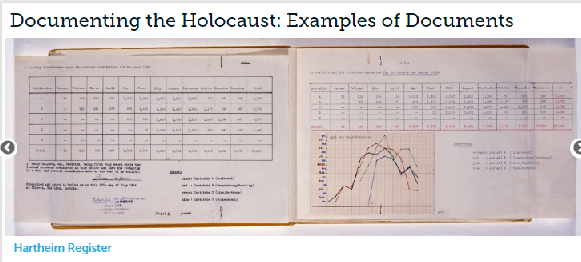
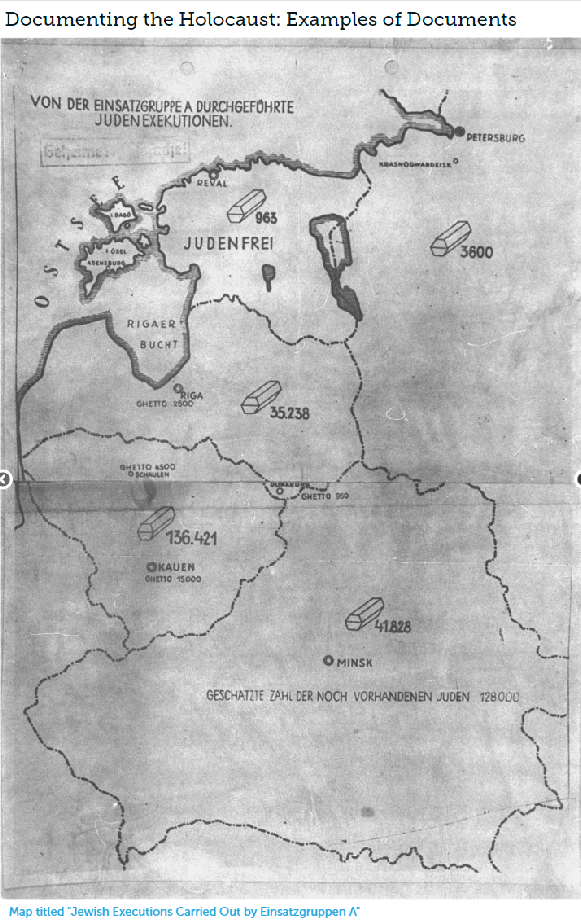
THE HOLOCAUST -
MURDER ON AN INDUSTRIAL SCALE
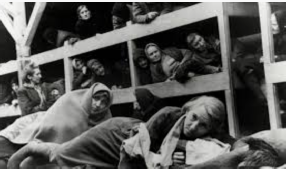
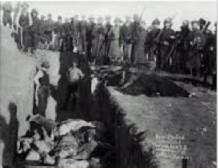
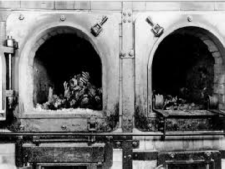
THE
INCREDIBLE
STORY OF THE JEWISH PEOPLE
RICHARD DIMBLEBY'S 1945 NEWS REPORT FROM BELSEN
WITH PHOTOGRAPHS
MISS NOBLE RMPS 2014 (13.05)
He was the BBC's war correspondent who accompanied the British 11th Armoured Division to the liberation of the Bergen-Belsen concentration camp, and described the scene in a report so graphic that the BBC declined to broadcast it for four days, relenting only when he threatened to resign:
...Here over an acre of ground lay dead and dying people. You could not see which was which... The living lay with their heads against the corpses and around them moved the awful, ghostly procession of emaciated, aimless people, with nothing to do and with no hope of life, unable to move out of your way, unable to look at the terrible sights around them ... Babies had been born here, tiny wizened things that could not live ... A mother, driven mad, screamed at a British sentry to give her milk for her child, and thrust the tiny mite into his arms, then ran off, crying terribly. He opened the bundle and found the baby had been dead for days.
This day at Belsen was the most horrible of my life. Wikipedia
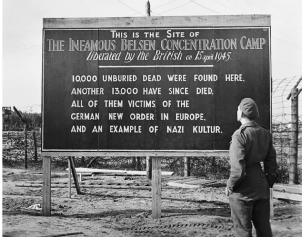
THE PATH TO NAZI GENOCIDE,
CHAPTER 1/4:
AFTERMATH OF WORLD WAR I
AND THE RISE OF NAZISM, 1918–1933
United States
Holocaust Memorial Museum 2016 (13.18)
THE PATH TO NAZI GENOCIDE,
CHAPTER 2/4:
BUILDING A NATIONAL COMMUNITY,
1933–1936
United States
Holocaust Memorial Museum 2016 (6.56)
THE PATH TO NAZI GENOCIDE,
CHAPTER 3/4:
FROM CITIZENS TO OUTCASTS,
1933–1938
United States
Holocaust Memorial Museum 2016 (7.28)
THE PATH TO NAZI GENOCIDE,
CHAPTER 4/4:
WORLD WAR II AND THE HOLOCAUST, 1939-45
United States
Holocaust Memorial Museum 2016 (13.54)
GENOCIDE: WORSE THAN WAR
Lorianne Clod 2015 (1.54.16)
Bassed o9n the Book
‘Worse Than War’
By Daniel Jonah Goldhagen
STANDING UP AGAINST GENOCIDE.
JEWISH RESISTANCE
DURING THE HOLOCAUST
Yehuda Bauer
Radboud Reflects, 2013 (1.55.18)
